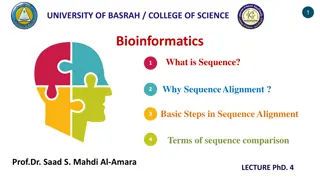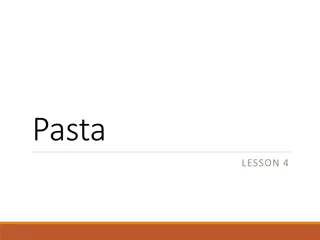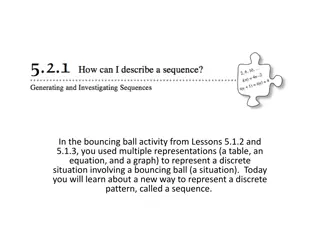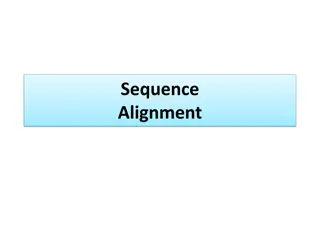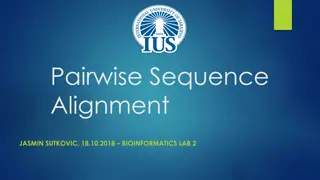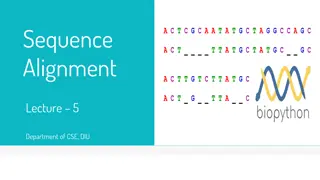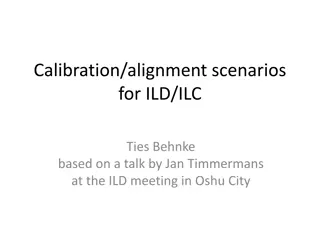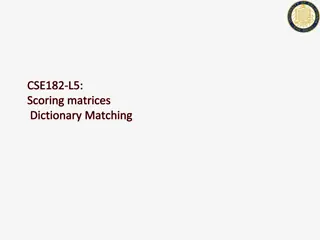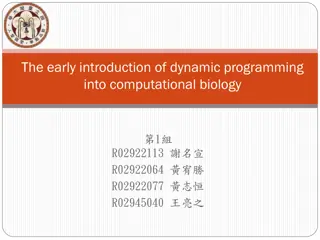Multiple Sequence Alignment with PASTA Algorithm
Explore the PASTA algorithm for multiple sequence alignment, from installation to using the GUI for alignment and tree estimation. Learn about SAT and PASTA algorithms, the input process, and the steps involved in obtaining the best ML score alignment/tree pair. Dive into the PASTA GUI, initial alignment, tree estimation, merging subset alignments, and more.
Download Presentation

Please find below an Image/Link to download the presentation.
The content on the website is provided AS IS for your information and personal use only. It may not be sold, licensed, or shared on other websites without obtaining consent from the author.If you encounter any issues during the download, it is possible that the publisher has removed the file from their server.
You are allowed to download the files provided on this website for personal or commercial use, subject to the condition that they are used lawfully. All files are the property of their respective owners.
The content on the website is provided AS IS for your information and personal use only. It may not be sold, licensed, or shared on other websites without obtaining consent from the author.
E N D
Presentation Transcript
Multiple Sequence Alignment with PASTA Michael Nute Austin, TX June 17, 2016
Agenda Quick recap of PASTA Algorithm Run the GUI Explore GUI options and what they do in terms of PASTA Run a test alignment Explore PASTA outputs and diagnostics Run a different test alignment Compare the PASTA fill-in-the-blank defaults for the two test alignments
PASTA: Installation We hope everybody has been able to install PASTA based on instructions from our email. If not: See detailed installation instructions at: https://github.com/smirarab/pasta Three Options: 1) MAC DMG file available at the link above 2) Linux Detailed instructions available at the link above Requires JAVA, wxPython, 3) Virtual Machine (Recommended: VirtualBox) Virtual appliance available at link above This is the only option for Windows users
SAT and PASTA Algorithms Obtain initial alignment and estimated ML tree Tree Estimate ML tree on new alignment Use tree to compute new alignment Alignment Repeat until termination condition, and return the alignment/tree pair with the best ML score 4
PASTA Algorithm Input: unaligned sequences 1) Get initial alignment 3) Break into subsets according to tree 2) Estimate tree on current alignment (repeat) 6) Use transitivity to merge subset pairs into a full alignment, scrap the old tree 4) Use external aligner to align subsets 5) Use external profile aligner to merge subset alignments ? 5
PASTA Algorithm PASTA GUI Initial Alignment 3 Get a Tree 1 2 3 This applies to the Tree Estimator in particular Transitivity merge ? Decompose 2 Align subsets 1) This is the alignment tool used to align the subsets (several options). 2) Tool for merging two subset alignments. (OPAL or MUSCLE) 3) Tool to estimate a maximum likelihood tree (FastTree or RAxML) Merge subset alignments pairwise 1 7
PASTA Algorithm 6 Initial Alignment Get a Tree This should be checked if the sequence file (4) should be treated as aligned. If not checked, PASTA will generate a fast progressive alignment to start. 5 4 Transitivity merge The basic input to the problem: FASTA file with sequences in need of alignment ? 4 Decompose <-- not implemented yet Data type (DNA, RNA or Protein) 5 6 The user can provide a starting tree that will cause the algorithm to skip the initial alignment step. Align subsets Merge subset alignments pairwise 8
PASTA Algorithm Initial Alignment Get a Tree Transitivity merge ? Basic administrative settings: Job Name all output files will start with this name. Output Dir folder where output files will go. CPUs number of processors Max. Memory (MB) only applies to Java when OPAL is called. Decompose Align subsets Merge subset alignments pairwise 9
PASTA Algorithm Decomposition Steps: Start by choosing a branch according to the Decomposition option (Centroid or Longest Branch). For each of the two subsets created, if the number of taxa is greater than Max. Subproblem, then repeat on that subset. Initial Alignment Get a Tree Stopping criteria for the decomposition. Can be either a fixed size or a percentage of the total taxa. Transitivity merge ? 7 Decompose 7 8 How to decide where to bisect the tree, (either Centroid Edge or the Longest Branch). 8 Align subsets Merge subset alignments pairwise 10
PASTA Algorithm Initial Alignment Get a Tree Transitivity merge ? Decompose When to Stop Running? (see below) Which iteration to return? (Final or Highest Likelihood) Should final tree be RAxML? Align subsets Merge subset alignments pairwise Two-Phase search is simply 1) run an alignment, 2) get a tree from it. This is completely different than PASTA and if this is checked, PASTA (formally) will not be run. 11
Example 1: small.fasta This is the PASTA install folder on the Virtual Machine Step 1: Read in the data. Located at <pasta- folder>/data/small. fasta Reads in the DATA and sets Type, prints some stats:
Example 1: small.fasta Importing the data caused the GUI to automatically set several settings based on the size, data type, etc It noticed that the data type was DNA It also noticed that this fasta file contains aligned sequences.
Example 1: small.fasta Step 2: name the job & set the output folder: Recommended: Use the create folder dialog to create a specific folder for these outputs.
Example 1: small.fasta Step 3:Say GO
= Important File Example 1: Examining the Output Folder Final Alignment: always in this name format: <jobname>.marker001.<original-fasta-name>.aln Job Output (Errors): contains PASTA console output when errors are reported. If this file is zero bytes, that is a good thing. Job Output: contains PASTA console output. Always good to examine this file after a run. Final Tree Intermediate alignments and trees after the initial search and after each iteration. Useful mainly for diagnostics and debugging Config File:This saves all the settings for this particular job. The same exact job can be re-run from the command line by running python run_pasta.py with the path to this file as the ONLY argument
Example 2: BBA0067 (time permitting) (protein data)
Final Tips & Best Practices After running an alignment, it is always a good idea to look at the console outputs generated to verify that PASTA did what it was expected to do. If the error file is non-zero size, read that too. The PASTA default settings are appropriate and well-chosen for most applications. Unless you have a good reason to use something else, this is a good starting point. PASTA scales with the number of cores available, so giving it as many processors as possible is a good idea. There are more settings available than what is in the GUI. Check the config file output for any pasta job to see the full list. Also can type python run_pasta.py h from the pasta folder to see a thorough help menu Approximate running time benchmarks (length=1500 base pairs): 100 Sequences: <10 minutes on a laptop 1000 Sequences: About 1-3 hours on a 16-core server 10000 Sequences: About 8-15 hours on a 16-core server (Should scale about linearly after this, but will depend on settings )
Resources PASTA User Group: https://groups.google.com/forum/#!forum/pasta-users Link to these slides: http://publish.illinois.edu/michaelnute/useful-files/ Github Repository (which has more documentation, including full install instructions): http://github.com/smirarab/pasta My Email: nute2@Illinois.edu
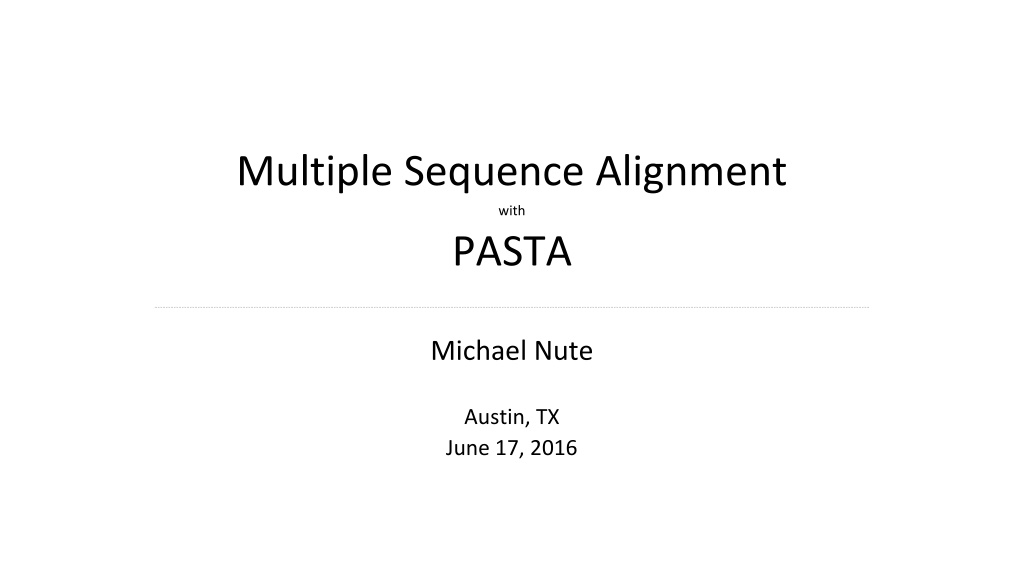
 undefined
undefined

